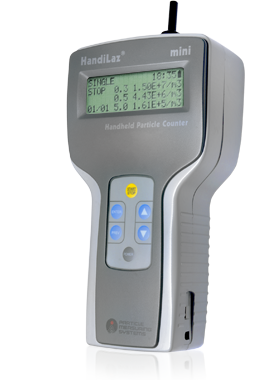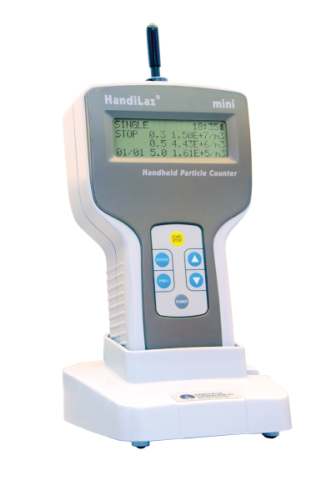Air Quality Monitor
The HandiLaz® Mini can be used to measure air in safety cabinets, cleanrooms and HEPA filtered incubators.
It provides an on-the-spot check that your air quality is as it should be, and that your air filtration system is producing Grade A air to ISO or EU GMP standards.
The HandiLaz® Mini handheld particle counter received the 2006 Most Impressive Development/Implementation of Advanced Technology Award, presented at the Cleanroom Technology Show in Boston, MA.
This product is available for sale in the U.S.A and selected countries in Europe and the rest of the world.

“Ensuring we provide and maintain optimal environmental conditions for our patients’ embryos whilst ex-vivo is one of the most fundamentally essential tasks of a successful lab”
Ronny Janssens, Centre for Reproductive Medicine, UZB, Brussels, Belguim

Key Features
Quick
A basic scan will take <1 minute
Extremely Accurate Counts
Particles as small as 0.3 microns
Practical
Up to 10,000 samples can be stored
Versatile
Easily connect by cable to an optional printer or PC
User Friendly
Reliable with an intuitive, easy-to-learn user interface
Why use the HandiLaz® Mini?
The HandiLaz® Mini can be used to measure HEPA filtered flow hoods, clean rooms and incubators. The HandiLaz® Mini provides an on-the-spot check that your air quality is up to scratch providing you with immediate verification that your air filtration system is producing the appropriate Grade air to ISO or EU GGMP standards.
The HandiLaz® Mini particle counter is ergonomically designed to fit in the palm of your hand. It is rugged and dependable, and provides accurate validation at a great price.
How does it work?
Air is drawn through the detection chamber by a pump. A laser beam is directed across the chamber and any particles contained in the air reflect the light, appearing as a bright flash.
The larger the particle, the brighter the flash. A photo detector measures the brightness of each flash and the meter counts and sorts them into the three size ranges. The software then calculates the results.
Validation
The HandiLaz® Mini is calibrated by NIST traceable particles and adheres to the same standards that an independent inspector does.
Data Analysis
The HandiLaz® Mini interfaces directly by cable to an optional printer or PC.
| Part Number | Part Description |
|---|---|
| 7-90-080 | Particle Counter. Accurate measurement of air-born particles in the lab |
| 7-90-083 | Replacement Zero Count Filter for Particle Counter |
| 7-90-305 | Calibration of Particle Counter |
Q: How is the HandiLaz Mini used?
A: The counter can be taken anywhere in the laboratory as it has rechargeable batteries. Simply hold or place it in the test environment and turn it on. The HandiLaz Mini samples the air for a user-defined time, counting the particles within three size ranges (0.3µm, 0.5µm and 5µm). At the end of the test, the results are displayed on the screen in units that can be immediately compared with pass and fail criteria given in the ISO or EU GGMP standards.
Q: How does the HandiLaz Mini work?
A: Air is drawn through the detection chamber by a pump. A laser beam is directed across the chamber and any particles contained in the air reflect the light, appearing as a bright flash. The larger the particle, the brighter the flash. A photo detector measures the brightness of each flash and the meter counts and sorts them into the three size ranges. The software then calculates the results.
Q: What do the numbers on the display mean?
A: They are the particle count per m³ of three particle sizes. We recommend the units are set to counts per m³.

